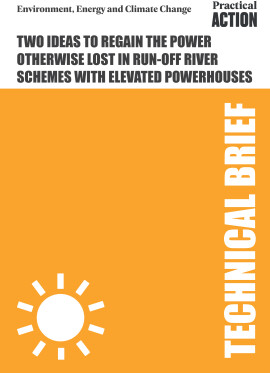
Modern Stoves for All
Revised edition of this practical survey of low-cost stoves for use in developing countries. Prepared for skilled technicians who will be able to use the drawings as a basis for building stove models, for testing and adaptation to local conditions.
Published: 1985
Pages: 96
eBook: 9781780442860
Paperback: 9780946688357
| 9781780442860.000 | 1 | ||
|---|---|---|---|
| 9781780442860.001 | 9 | ||
| Part I ― Basic Principles | 9 | ||
| A. Firewood as a Fuel | 10 | ||
| B. The Essentials of Efficient Stoves | 10 | ||
| C. The Main Characteristics of Firewood | 10 | ||
| ―Composition | 10 | ||
| ―Heat Value | 11 | ||
| ―Density | 11 | ||
| ―Moisture Content | 11 | ||
| D. The Process of Wood Combustion | 12 | ||
| ―Optimal Size of Firewood | 12 | ||
| ―Air Supply | 12 | ||
| E. The Stages of Wood Combustion | 12 | ||
| ―The Three Stages | 13 | ||
| ―Flame Temperature | 13 | ||
| ―Fire–Lighters | 13 | ||
| F. Primary and Secondary Air | 13 | ||
| ―The Importance of Secondary Air | 13 | ||
| ―Pre–Heating the Air Supply | 13 | ||
| G. Winning Acceptance for New Methods | 14 | ||
| ―Advantages of Open–Fire Cooking | 14 | ||
| ―Disadvantages of Open–Fire Cooking | 14 | ||
| H. The Evolution from Open Fires to Modern Stoves in Developed Countries | 15 | ||
| ―Diminishing Heat Loss through Radiation | 15 | ||
| ―Reducing Heat Loss Caused by Convection | 15 | ||
| ―Increasing Heat Absorption by Conduction | 16 | ||
| I. Basic Components of Wood-Burning Stoves | 16 | ||
| ―The Fire–Box | 16 | ||
| ―The Grate | 16 | ||
| ―The Doors | 18 | ||
| ―The Heating Plates | 19 | ||
| ―Dampers and Baffles | 20 | ||
| ―The Chimney | 20 | ||
| ―The Cowl | 22 | ||
| ―General Proportions of Stove Components | 22 | ||
| Part II ― Cooking Pots, Alternative Fuels and Cooking Methods | 23 | ||
| J. Cooking Pots | 24 | ||
| K. Alternative Fuels | 25 | ||
| ―Bundles and Faggots | 25 | ||
| ―Briquettes | 27 | ||
| L. Other Fuels | 30 | ||
| ―Kerosene | 30 | ||
| ―Diesel Oil | 32 | ||
| ―Bottled Gas | 32 | ||
| ―Biogas | 32 | ||
| M. Hay Boxes | 33 | ||
| N. Cooking Methods | 34 | ||
| Short–term Versus Long–term Cooking | 34 | ||
| ―The Cooking System | 34 | ||
| Part III ― Description, Construction and Testing of Stove and Oven Models | 35 | ||
| O. Preparation of Clay | 36 | ||
| ―Resistance to Thermic Shocks | 36 | ||
| ―'Grogging' | 37 | ||
| ―The Hay Method | 37 | ||
| P. Stove Models | 37 | ||
| ―Well–Managed Open Fire | 37 | ||
| ―Protected Open Fire | 39 | ||
| ―Crescent Stove | 42 | ||
| ―Pogbi or 'Ruthigiti' Stove | 45 | ||
| ―Peasant Stove | 51 | ||
| ―Rural Stove | 53 | ||
| ―Farmhouse Stove | 55 | ||
| Q. Portable Metal Braziers | 57 | ||
| ―The Polish Stove | 57 | ||
| ―The Nomad Stove | 61 | ||
| ―The Family Stove | 64 | ||
| R. The Use of Charcoal | 66 | ||
| ―The Kenyan Jiko | 67 | ||
| S. Community Stoves | 70 | ||
| T. Bread Ovens | 78 | ||
| ―Construction | 79 | ||
| U. Home Heating Devices | 84 | ||
| V. The Testing of Wood Stoves | 86 | ||
| ―The Importance of Testing | 86 | ||
| ―The Short Water Boiling Test | 90 | ||
| ―The Long Water Boiling Test | 90 | ||
| ―Demonstration of the Relative Fuel Efficiency of Stoves | 91 | ||
| ―Improving the Reliability of Tests | 92 | ||
| ―The Hierarchy of Tests | 92 | ||
| ―Reporting Forms | 93 | ||
| ―Other Tests on Wood Stoves | 93 | ||
| ―The Eindhoven Formula | 94 |
Waclaw Micuta
waclaw Micuta died in 2008. He was was a Polish economist, functionary of the United Nations and a soldier. He was also a pioneer in and a tireless supporter of renewable energy and the founder of Renewable Energies Development Institute in Geneva.[10] While working for institute he developed a low cost fuel efficient stove which could be easily constructed and used in poor countries.[11]
Energy-Efficient Design of a Cook Stove
RAJPAL, P. S.
SHISHODIA, K. S.
SEKHON, G. S.
Energy Sources, Vol. 16 (1994), Iss. 3 P.387
https://doi.org/10.1080/00908319408909085 [Citations: 3]Portable single-pan wood stoves of high efficiency for domestic use
Mukunda, H S
Shrinivasa, U
Dasappa, S
Sadhana, Vol. 13 (1988), Iss. 4 P.237
https://doi.org/10.1007/BF02759888 [Citations: 26]Design, development and technological advancement in the biomass cookstoves: A review
Tyagi, S.K.
Renewable and Sustainable Energy Reviews, Vol. 26 (2013), Iss. P.265
https://doi.org/10.1016/j.rser.2013.05.010 [Citations: 115]




